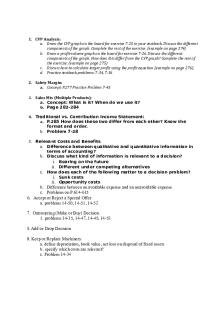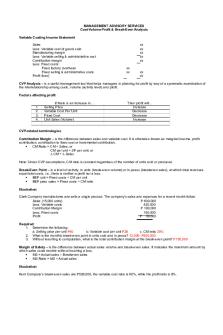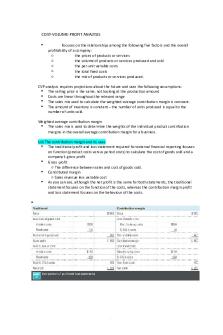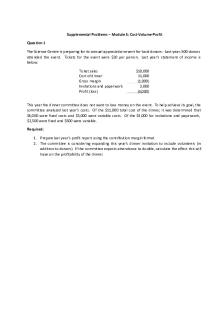COM 316 Chapter 7: CVP PDF

| Title | COM 316 Chapter 7: CVP |
|---|---|
| Author | John Fraser |
| Course | Management Accounting |
| Institution | University of Victoria |
| Pages | 10 |
| File Size | 713.5 KB |
| File Type | |
| Total Views | 189 |
Summary
Chapter 7 textbook notes, CVP analysis,. and...
Description
Activity Based Costing: A tool to Aid Decision Making The Treatment of Costs Under the Activity-Based Costing (ABC) Model LO 1: Explain the activity-based cost model and how it differs from traditional costing systems. Several differences distinguish abc from traditional cost accounting: 1. Non-manufacturing as well as manufacturing costs may be assigned to products, but only on a cause-and-effect basis. ○ In traditional cost accounting, only manufacturing costs are assigned to products. ○ Selling/Admin expenses are treated as period costs, not assigned to products. 2. Some manufacturing costs may be excluded from product costs. ○ In traditional accounting, all manufacturing costs are assigned to products - even material costs that are not caused by the products. ○ For example, in ch.5 we saw how a predetermined plantwide overhead rate is computed, and in that approach it spreads all manufacturing overhead costs among all products. Commonly referred to as the peanut butter spreading approach. ■ ABC only assigns costs to a product if there is good reason to believe that the cost would be affected by decisions concerning the product. 3. Numerous overhead cost pool are used, each of which is allocated to products and other cost objects using its own unique measure of activity. 4. Overhead rates, or activity rates, may be based on the level of activity at capacity rather than on the budgeted level of activity.
● ●
Overhead Cost Pools - Groups of overhead cost elements. In ABC, an activity is any event that causes the consumption of overhead resources.
●
Activity Cost Pool - A “bucket” in which costs are accumulated that relate to a single activity measure in the activity-based costing system. ● Activity Measure - An allocation base in an activity-based costing system; ideally, a measure of the amount of activity that drives the costs in an activity cost pool; also called a cost driver. ● Transaction Driver - A simple count of the number of times an activity occurs. ● Duration Driver - A measure of the amount of time required to perform an activity. ● Many companies continue to base overhead allocations on cost drivers that vary with volume of production or service provided. ○ In situations where overhead costs and direct labor hours are highly correlated or in situations where the goal of the overhead allocation process is mainly to prepare external financial reports, this practice does make sense. ○ However, if plantwide overhead costs do not move in tandem with plantwide direct labor-hours or machine-hours, product costs will be distorted. ● ABC addresses this issue by defining five levels of activity: ○ Unit-level activities (1) - Activities that arise as a result of the total volume of goods produced and services performed each time a unit is produced. The costs of unit-level activities should be proportional to the number of units produced. ○ Batch-level activities (2) - activities performed each time a batch of goods is handled, regardless of how many units are in a batch. The amount of resources consumed depends on the number of batches run rather than on the number of units in the batch. ■ They are incurred once for each batch (or customer order). ■ Costs at the batch level depend on the number of batches processed rather than on the number of units produced, the number of units sold, or other measures of volume. ○ Product-level activities (3) - activities that relate to specific products that must be carried out regardless of how many units produced and sold or batches run. ○ Customer-level activities (4) - activities that are carried out to support customers but that are not related to any specific product. ○ Organization-sustaining activities (5) - Activities that are carried out regardless of which customers are serviced, which products are produced, how many batches are run, or how many units are made. Activity Rates Based on Capacity, Not Budget ● In a traditional absorption costing system, predetermined overhead rates are computed by dividing budgeted overhead costs by a measure of budgeted activity such as budgeted direct labor-hours. ○ This results in applying the costs of unused, or idle, capacity to products, and it results in unstable unit product costs. ○ If budgeted activity falls, the overhead rate increases because the fixed components of overhead are spread over a smaller base, resulting in increased unit product costs. ● In ABC, products are charged for the costs of capacity they use - not for the costs of capacity that they do not use.
○ In other words, the costs of idle capacity are not charged to products. Designing an Activity-Based Costing System ● Three essential characteristics of a successful ABC implementation: ○ First, top managers must strongly support the implementation because their leadership is instrumental in properly motivating all employees to accept the need for change. ○ Second, top managers should ensure that ABC data are linked to how people are evaluated and rewarded. ■ If employees continue to be evaluated and rewarding traditional (nonABC) cost data, they will ignore the information provided about ABC. ○ Third, a cross-functional team should be created to design and implement the ABC system. ■ The team should include representatives from each area that will be using the ABC data. ■ They also have knowledge that is crucial to starting a legitimate system, company wide. ■ Also reduces the resistance to change.
The process can be broken down into 5 simple steps: Step 1: Identify and define activities, activity cost pools, and activity measures. ● Activities may be grouped in a category such as material handling. ● Activities should be grouped together at the appropriate level. ● Batch-level activities should not be combined with unit-level activities, or product-level activities, etc. ● It is best to group activities that are highly correlated together.
●
Customer Orders cost pool is assigned all costs of resources that are consumed by taking and processing customer orders, including costs of processing paperwork and any costs involved in setting up machines for specific orders. ○ This is a batch-level activity, since each order generates work that occurs regardless whether the order is for 1 unit or 1,000 units. ● Product Design cost pool is assigned all costs of resources consumed in designing products. The activity measure is the number of products designed. ○ This is a product-level activity, sich the amount of design work on a new product does not depend on the number of units ultimately ordered or batches ultimately run. ● The Order Size cost pool is assigned all costs of resources consumed as a consequence of the number of units produced, including the cost of miscellaneous factory supplies, power to run machines, and some equipment depreciation. ○ This is a unit-level activity, since each unit requires some of these resources. ● The Customer Relations cost pool is assigned all costs associated with maintaining relations with customers, including the costs of sales calls and the costs of entertaining customers. ○ Activity measure - the number of customers the company has on its active customer list. ○ Represents a customer-level activity. ● The Other cost pool is assigned all overhead costs that are not associated with customer orders, product design, production units, or customer relations. ○ These costs consist mainly of organization-sustaining costs and the costs of unused, idle capacity. ■ These types of costs should not be assigned to products since they represent resources that are not consumed by the product. Step 2: Assign overhead costs to activity cost pools. LO 2: Assign costs to cost pools using a first-stage allocation, and compute activity times.
● ●
Once the ABC system is designed, the team is ready to begin the process of actually computing the costs of products, customers, and other objects of interest. Assigning costs to cost object under ABC is a two-stage process: ○ Stage 1: Manufacturing and non-manufacturing overhead is allocated to the
○
●
activity cost pools. Stage 2: Costs for the activities are allocated to the various cost objects.
Notice that direct materials, direct labour, and shipping are excluded from the costs shown above. ○ This is because the existing costing system can accurately trace these factors to products. ● The ABC system in this example will divide the nine types of overhead costs in the above statement among ts activity cost pools via an allocation process called firststage allocation. ● First-stage Allocation - The process by which overhead costs are assigned to activity cost pools in an activity-based costing system. ● First-stage allocations are usually based on the results of interviews with employees who have first-hand knowledge of the activities. ● I.e. if you had to figure out indirect factory wages, you would ask an indirect employee to estimate what percentage of their time is spent dealing with customer orders, with product
design, with processing units of product, etc.. See beside for example. Now that the first-stage allocations to the activity costs pools have been completed, the next step is to compute the activity rates. Step 3: Calculate activity rates. ● ●
Second-Stage Allocation of Overhead Costs LO 3: Assign costs to a cost object using second-stage allocation. Step 4: Assign overhead costs to cost objects using the activity rates and activity measures. ● See below for an example of data needed to assign overhead costs:
● ● ●
●
●
Notice that 600 customer orders were placed for standard stanchions and 400 customer orders were placed for custom compass housings, for a total of 1,000 customer orders. All 400 product designs related to custom compass housings; none related to standard stanchions. Producing 30,000 standard stanchions required 17,500 machine-hours, and producing 1,250 custom compass housings required 2,500 machine-hours, for a total of 20,000 machine-hours.
Note, the sum of these two products is $952,000, which is less than the $1,810,000 of overhead costs identified previously. ○ This is because the ABC team purposely did not assign the $367,500 of Customer Relations and $490,500 of Other costs to products. ○ The customer relations activity is a customer-level acitivity and the other activity costs are added to the $952,000 of overhead costs assigned to products, totalling $1,810,000. Next, we need to assign activity costs to customers. The data we need to assign overhead costs to one of its customers is as follows:
●
As shown, the ABC team calculated that $6,423 of overhead costs should be assigned to Windward Yachts. ● Now, with the second stage being complete the ABC team is ready to begin creating reports. Product and Customer Margins LO 4: Use activity-based costing to compute product and customer margins Step 5: Prepare management reports. ● The ABC cost allocations summarize only each product’s indirect (i.e., overhead costs). Therefore, to compute a product’s profit (i.e. product margin), the design team needed to gather each product’s sales and direct costs in addition to the overhead costs previously computed. ● The pertinent sales and direct cost data for each product:
●
Once gathered this information, a product profitability report can be created:
●
As seen above, the standard stanchions are profitable, with a positive product margin of
●
$906,250, whereas the compass housing are unprofitable, with a negative product margin of $49,500. ○ Keep in mind, this report purposely does not include the costs in the Customer Relations and Other activity cost pools. ○ These costs are excluded from the report because they are not caused by the products. They are caused by customers, not products. The product margins can be reconciled with the company’s operating income as follows:
●
Next, you must create a customer profitability report for Windward Yachts. Similar to the product profitability report, the design team needed to gather data concerning sales to Windward Yachts and the direct material, labour, and shipping costs associated with those sales:
● ●
ABC systems can also be used to calculate supplier costs and margins. Just like customers, suppliers have a large effect on costs.
●
Activity pools related to supplier costs might be set up to include purchasing, receiving, inspection of incoming components, warranty and rework costs, etc. ○ Once they are accumulated in the activity pool costs, they can be assigned to particular suppliers based on the cost drivers selected. ● Activity-based management (ABM) utilizies information from the ABC system to target activities in need of process improvements. Benchmarking performance against worldclass organizations or other high-performing divisions within the same organization can help identify activities most in need of improvement. Comparison of Traditional and Activity-Based Costing Product Costs LO 5: Compare product costs computed using traditional and activity-based costing methods. ● Product costs computed under ABC are often quite different from the costs generated by a company’s traditional cost accounting system because ABC assigns only costs caused by products, uses activity measures that are not necessarily volume related, and assigns non-manufacturing costs such as shipping on a cause-and-effect basis....
Similar Free PDFs

COM 316 Chapter 7: CVP
- 10 Pages

COM 316 Syllabus - Monday Only
- 10 Pages

CVP - Chapter 6 on CVP
- 2 Pages

Chapter 22 - CVP Analysis
- 52 Pages

Maturity scan OBS 316
- 2 Pages

CVP Analysis - CVP
- 9 Pages

CVP MANAGEMENT Chapter 5 summary
- 8 Pages

06 CVP Relationships
- 51 Pages

CVP Drill
- 4 Pages

B7 SIST COM - Apuntes 7
- 8 Pages

CHAPTER 3 BISNESS COM
- 6 Pages

MAS CVP Reviewer
- 26 Pages

316 Cover Letter Final
- 2 Pages

Anat 316 - winter 2021
- 9 Pages

Com 123 Chapter 3 Notes
- 4 Pages

Supplemental Problems CVP up
- 5 Pages
Popular Institutions
- Tinajero National High School - Annex
- Politeknik Caltex Riau
- Yokohama City University
- SGT University
- University of Al-Qadisiyah
- Divine Word College of Vigan
- Techniek College Rotterdam
- Universidade de Santiago
- Universiti Teknologi MARA Cawangan Johor Kampus Pasir Gudang
- Poltekkes Kemenkes Yogyakarta
- Baguio City National High School
- Colegio san marcos
- preparatoria uno
- Centro de Bachillerato Tecnológico Industrial y de Servicios No. 107
- Dalian Maritime University
- Quang Trung Secondary School
- Colegio Tecnológico en Informática
- Corporación Regional de Educación Superior
- Grupo CEDVA
- Dar Al Uloom University
- Centro de Estudios Preuniversitarios de la Universidad Nacional de Ingeniería
- 上智大学
- Aakash International School, Nuna Majara
- San Felipe Neri Catholic School
- Kang Chiao International School - New Taipei City
- Misamis Occidental National High School
- Institución Educativa Escuela Normal Juan Ladrilleros
- Kolehiyo ng Pantukan
- Batanes State College
- Instituto Continental
- Sekolah Menengah Kejuruan Kesehatan Kaltara (Tarakan)
- Colegio de La Inmaculada Concepcion - Cebu